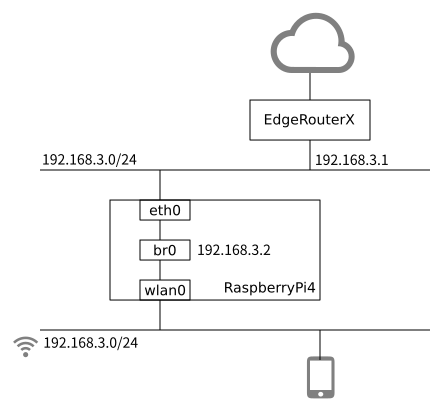Raspberry Pi 4 に CentOS 7 をインストールして自宅の無線LANアクセスポイントを構築したので手順をまとめておきます。
ネットワーク構成は以下の通りです。インターネットとはEdgeRouterXを介して接続されていて、LAN側のゲートウェイのアドレスは192.168.3.1です。また、このインタフェースではDHCPとDNSのサービスが動作しています。
今回は、CentOSの仮想ブリッジを利用して、EdgeRouterXから出ている192.168.3.0/24のネットワークをそのまま無線LAN側に接続しています。
起動用 SD の作成
armv7 向け CentOS7 のイメージをダウンロードして起動用 SD カードに書き込みます。
SD カードは作業用 PC に挿入されていて、/dev/sdd で認識されている状態です。このあたりは適宜読み替えてください。(マウントされていると失敗するので、アンマウントしておきます)
$ wget https://people.centos.org/pgreco/images/forrpi4v2/CentOS-Userland-7-armv7hl-RaspberryPI-Minimal-exp4-1810-sda.raw.xz
$ tar xf CentOS-Userland-7-arm7hl-RaspberryPI-Minimal-exp4-1810-sda.raw.xz
$ sudo dd bs=4M if=CentOS-Userland-7-armv7hl-RaspberryPI-Minimal-exp4-1810-sda.raw of=/dev/sdd conv=fsync status=progress
ネットワークの初期設定
SD カードを Raspberry Pi 4 に挿入して電源を投入し、しばらく待つと DHCP で IP アドレスを取得して root で SSH ログインが可能な状態になります。初期パスワードは centos です。IP アドレスはルータのログ等から適当に調べます。
$ ssh root@192.168.3.xxx
[root@localhost ~]# passwd # root パスワードの変更
[root@localhost ~]# hostnamectl set-hostname rpap # ホスト名の変更
[root@localhost ~]# timedatectl set-timezone Asia/Tokyo # タイムゾーンの設定
[root@localhost ~]# systemctl stop firewalld # firewalld を無効にする
[root@localhost ~]# systemctl disable firewalld
[root@localhost ~]# vi /etc/sysconfig/selinux # selinux を無効にする
-SELINUX=enforcing
+SELINUX=disabled
[root@localhost ~]# vi /etc/NetworkManager/NetworkManager.conf # DNSの自動設定を無効にする
+dns=none # [main]セクションの中に追記
[root@localhost ~]# vi /etc/resolv.conf # DNSの設定
-# Generated by NetworkManager
+nameserver 192.168.3.1
[root@localhost ~]# vi /etc/sysconfig/network-scripts/ifcfg-br0 # 新規作成
+NAME=br0
+DEVICE=br0
+TYPE=Bridge
+BOOTPROTO=static
+ONBOOT=yes
+IPADDR=192.168.3.2
+NETMASK=255.255.255.0
+NETWORK=192.168.3.0
+GATEWAY=192.168.3.1
[root@localhost ~]# vi /etc/sysconfig/network-scripts/ifcfg-eth0 # 新規作成
+NAME=eth0
+DEVICE=eth0
+TYPE=Ethernet
+BOOTPROTO=static
+ONBOOT=yes
+BRIDGE=br0
[root@localhost ~]# vi /etc/sysconfig/network-scripts/ifcfg-wlan0 # 無線LANインタフェースの設定を新規作成
+NAME=wlan0
+DEVICE=wlan0
+TYPE=Ethernet
+BOOTPROTO=static
+ONBOOT=yes
+BRIDGE=br0
MACアドレスランダム化を無効にする
CentOS7 の NetworkManager は、無線 LAN クライアントの位置情報追跡を困難にするため、定期的に無線 LAN インタフェースの MAC アドレスを変更する機能がデフォルトで有効になっています。
AP として動作させる場合にこの機能が有効になっていると、変更のタイミングで接続が切れたりするので、無効にしておきます。
[root@localhost ~]# vi /etc/NetworkManager/conf.d/30-no-mac-randomization.conf
+[device-mac-randomization]
+wifi.scan-rand-mac-address=no
必要なパッケージの追加
[root@localhost ~]# yum -y install iptables-services bridge-utils net-tools bind-utils tcpdump wget
無線LANインタフェースの設定ファイル取得
[root@localhost ~]# wget -O /usr/lib/firmware/brcm/brcmfmac43455-sdio.txt https://raw.githubusercontent.com/RPi-Distro/firmware-nonfree/master/brcm/brcmfmac43455-sdio.txt
hostapd のインストール
[root@localhost ~]# vi /etc/yum.repos.d/epel.repo # 新規作成
+[epel]
+name=Epel rebuild for armhfp
+baseurl=https://armv7.dev.centos.org/repodir/epel-pass-1/
+enabled=1
+gpgcheck=0
[root@localhost ~]# yum -y install wireless-tools hostapd
[root@localhost ~]# mv /etc/hostapd/hostapd.conf . # バックアップ
[root@localhost ~]# vi /etc/hostapd/hostapd.conf # 新規作成
+ctrl_interface=/var/run/hostapd
+ctrl_interface_group=wheel
+macaddr_acl=0
+auth_algs=1
+ignore_broadcast_ssid=0
+wpa=2
+wpa_key_mgmt=WPA-PSK
+rsn_pairwise=CCMP
+wpa_passphrase=hogehoge
+driver=nl80211
+interface=wlan0
+bridge=br0
+hw_mode=g
+channel=1
+ssid=ore_no_musen_lan
+country_code=JP
+ieee80211d=1
[root@localhost ~]# systemctl enable hostapd
無線LANパワーマネジメントの無効化
無線LANのパワーマネジメントが有効になっていると、起動後時間が経過するとパフォーマンスが低下するため、これを無効にします。hostapdが起動したタイミングで無効になります。
[root@localhost ~]# vi /usr/lib/systemd/system/hostapd.service
+ExecStartPost=/sbin/iw dev wlan0 set power_save off
仮想ブリッジを通過するパケットに iptables を適用する
CentOS 7 のデフォルトでは、仮想ブリッジを通過するパケットには iptables のルールが適用されないようなので、これを変更します。
[root@localhost ~]# /etc/sysconfig/modules/br_netfilter.modules
+#!/bin/sh
+/sbin/modprobe br_netfilter >/dev/null 2>&1
[root@localhost ~]# chmod 755 /etc/sysconfig/modules/br_netfilter.modules
これで、iptables の FORWARD チェインのルールが適用されるようになります。
再起動
[root@localhost ~]# shutdown -r now
しばらく待つと SSID が ore_no_musen_lan なアクセスポイントが出てきます。
